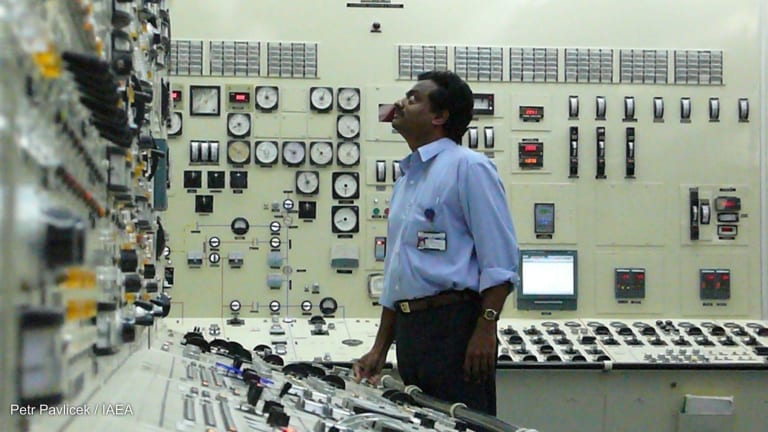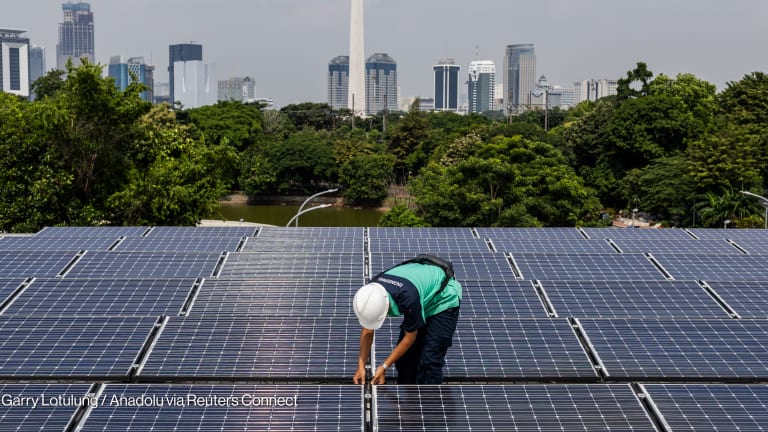
MEXICO CITY — Long known for its oil fields, Mexico has, in a little over a decade, become a regional leader in climate policy — at least nominally.
In 2009, under the administration of then-President Felipe Calderón, Mexico adopted ambitious goals to reduce carbon emissions and produce more than one-third of its energy from renewables by 2024. For a while, it looked like Mexico could be an example of a successful rapid transition to clean energy.
Cancún to Mayan ruins: Mexico’s new train leaves locals and environment behind
The government hopes the infrastructure project will jump-start an economy in crisis and “spread the wealth” to the country’s poorest states. But scientists, NGOs, and communities argue that it responds to corporate interests and flies in the face of indigenous land rights.
Progress has been slow, however, and investment is predicted to fall as the new administration has favored the oil industry over continuing to boost renewable energy. Despite his campaign pledges to increase environmental protection, President Andrés Manuel López Obrador, commonly known as AMLO, has undermined renewable energy projects while in office, postponing energy auctions and attempting to remove other incentives for the industry.
In May, Mexico indefinitely halted critical tests for new clean energy projects due to the COVID-19 pandemic. The opposition Institutional Revolutionary Party said the move was an intentional effort to curtail private investment in renewable energy.
If Mexico were to pursue a transition to clean energy more seriously, much of that could come from the Isthmus of Tehuantepec in the southwestern state of Oaxaca. This region has some of the best wind in the world for generating renewable energy: Gusts are so strong that they can turn over cars, tear off roofs, or — when harnessed correctly — provide power for swaths of the country.
But this isthmus is more than just the sum of its resources. A fiercely independent region and home to two indigenous peoples — the Zapotec and the Huave — the Isthmus of Tehuantepec presents unique challenges.
Understanding the needs of these local stakeholders and winning community consent is often key to the success of wind power projects. Local, national, and international NGOs are trying to mediate between the priorities of clean power and the rights of those that live on the isthmus.
There are many questions raised by Mexico’s recent experiment with clean power. Does the greater environmental benefit of clean energy outweigh localized impacts to wildlife and farming? And should renewable energy follow the same model as carbon-based energy industries, or is a transition to clean energy an opportunity to examine other inequities in how electricity is produced?
As other countries attempt to make a meaningful transition to greener energy generation to mitigate the effects of global warming — India, for example, has a booming solar power sector — they may grapple with the same concerns.
Ensuring fair consultation of indigenous communities
On the isthmus, a rapid growth in wind farms has drawn a mixed response from local residents. In the town of Union Hidalgo, Demex, the Mexican subsidiary of Renovalia Energy, has built two wind farms that provide 237.5 megawatts of power for Mexican bakery giant Bimbo and U.S. supermarket chain Walmart. Most wind farms in the region use a “self-supply” model, in which corporations invest in projects in return for clean energy at a reduced cost.
But the project was not without controversy. Some residents who signed lease agreements later said they were misled and are currently challenging the contracts in court. For many residents of Union Hidalgo, where another wind farm is currently undergoing a public consultation before construction begins, these experiences undermined their faith in the local model of clean energy.
“The landholders who gave their property realized that there were many irregularities in their contracts,” said Andrea Manzo, a Union Hidalgo resident critical of the new wind farm being planned. According to Manzo, the process did not meet requirements under Mexican law to translate information into the Zapotec language or properly inform the signatories of the negative impacts of the wind turbines. Demex has denied these claims.
“While we believe very firmly that rapid energy transition is absolutely essential to bending the curve of carbon emissions, it really matters how it is done.”
— Dominic Boyer, anthropologist, Rice UniversityElsewhere on the isthmus, residents of nearby San Dionisio del Mar blocked roads and protested for a year in 2012, ultimately forcing what would have been the largest wind farm in the region to search for a new location. They said the wind farm — known as Mareña Renovable — would have ended the subsistence fishing they depended on for their livelihoods.
Mexican law has a consultation process to allow indigenous communities to vote on such projects, but in practice the process is often fraught. Under the International Labour Organization’s Convention 169, which Mexico ratified in 1990, indigenous communities must be consulted on infrastructure and other projects that affect them or the land they live on.
The consultation process for a new wind farm in Union Hidalgo is ongoing and involves three stages, in which communities establish the procedure for voting and attend informative assemblies before finally casting the deciding vote on whether the project can go ahead. The process is currently on hold as a result of public health measures aimed at slowing the spread of the new coronavirus.
But this consultation procedure often fails to live up to the standards of the law, according to the Mexico City-based ProDESC, a land-rights NGO that has overseen similar consultations on the isthmus. The organization has brought injunctions against local authorities when it has detected violations of communities’ rights.
A fair consultation process “should respect people, not impose, trick, or lie to advance or obtain a specific result,” Juan Antonio López, a lawyer with ProDESC, told Devex in February. Campaigners critical of wind projects in the area have been subject to a campaign of intimidation and harassment, according to the NGO.
As a result, ProDESC, representing a group of Union Hidalgo residents, has brought a series of injunctions that it has said will — when they are resolved by a judge — set a precedent for how companies and governments need to consult indigenous communities on planned infrastructure projects. If the judge upholds the injunctions, the consultation process will need to be repeated, López added, in what would be the first case in Mexico of activists successfully blocking a project before construction begins.
The conflicts on the isthmus also point to broader, unresolved questions about how society should distribute the benefits of energy projects to local residents.
If not implemented correctly, renewable energy risks repeating the mistakes of carbon-based energy, according to Dominic Boyer, an anthropologist at Rice University. Boyer, who authored a book about wind energy on the Isthmus of Tehuantepec, has argued that carbon-based extraction models have frequently failed to distribute benefits to the majority, harming the environment while delivering wealth to a small minority.
NGOs supporting alternatives?
Many of those unhappy with the status quo are not against wind energy per se but object to the form it often takes in the region, where large multinational companies dominate the field. There is also limited opportunity for small-scale alternatives or projects that lower the cost of electricity for local communities.
An alternative to this model would be a community-centered wind farm, where much of the profit is directed back into resources for local people, Boyer said. One such project — with support from The Yansa Group, which partners with communities to produce renewable energy — was attempted but struggled to gain regulatory approval. Under AMLO’s administration, there has been little progress as he pushes for a return to a state-centered energy policy focused on the oil industry.
“It's a real tragedy that AMLO hasn't taken the opportunity to move this forward. It would be a golden opportunity to build on what Calderon did but taking it in a populist direction,” Boyer said.
Despite the model’s controversies and the new administration’s limited enthusiasm for renewables, the industry is still growing. In 2019, wind power increased its installed capacity by 26% compared with the previous year, and the sector expects to add almost as much in 2020. But the shape of this development — and its relationship with people in the region — is still a subject of fierce debate in Mexico.
“While we believe very firmly that rapid energy transition is absolutely essential to bending the curve of carbon emissions, it really matters how it is done,” Boyer said.








